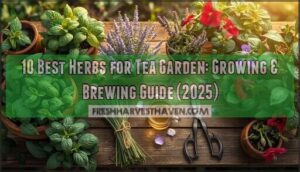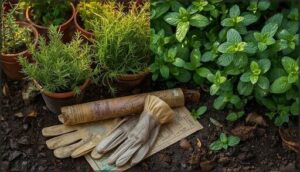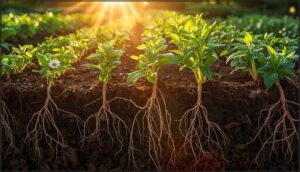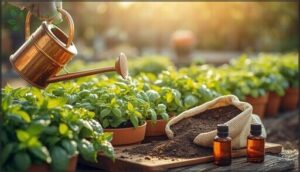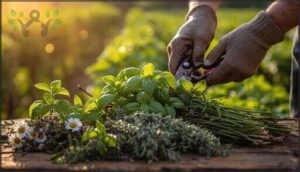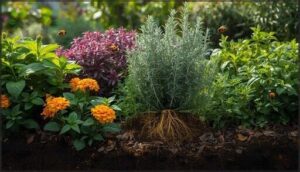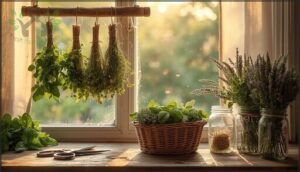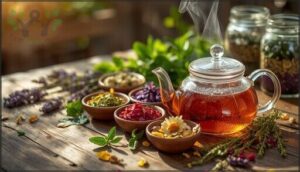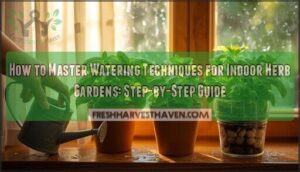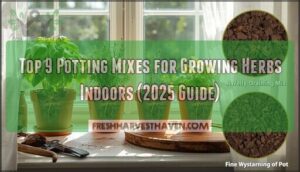This site is supported by our readers. We may earn a commission, at no cost to you, if you purchase through links.
A well-stocked tea garden transforms your backyard into a personal apothecary, where fresh chamomile blooms beside fragrant mint and vibrant hibiscus flowers. Growing your own tea herbs means you control every step—from soil to cup—ensuring pure, pesticide-free brews that store-bought bags can’t match.
Beyond flavor, cultivating the best herbs for tea garden spaces connects you to centuries-old traditions while delivering measurable health benefits, from chamomile’s proven calming effects to peppermint’s digestive support.
Whether you’re working with a sprawling plot or a handful of containers on a sunny balcony, the right herb selections adapt to your climate and skill level while producing abundant harvests season after season.
Table Of Contents
- Key Takeaways
- Top Herbs for a Tea Garden
- Chamomile – Calming and Floral
- Peppermint and Spearmint – Refreshing Mints
- Lemon Balm and Lemon Verbena – Citrusy Notes
- Lavender – Relaxation and Aroma
- Hibiscus – Tart and Vibrant
- Calendula – Soothing and Colorful
- Echinacea – Immune Support
- Holy Basil (Tulsi) – Stress Relief
- Valerian – Natural Sleep Aid
- Ginger and Licorice Root – Spicy and Sweet
- Choosing The Right Herbs for Your Climate
- Planting and Caring for Tea Garden Herbs
- Harvesting and Storing Herbal Tea Plants
- Blending and Brewing Your Herbal Teas
- Frequently Asked Questions (FAQs)
- What herbs can I grow in my herbal tea garden?
- What is the best herbal tea?
- What plants make good tea?
- What can you grow in a tea garden?
- Can You Grow your own herbal tea garden?
- What are the best herbs for iced tea?
- What herbs for a tea garden?
- What fresh herbs make the best tea?
- Which herbs grow best in partial shade conditions?
- How long do herbal tea plants typically live?
- Conclusion
Key Takeaways
- Growing your own tea herbs like chamomile, peppermint, and lavender gives you pesticide-free brews with measurable health benefits, from chamomile’s 29% sleep quality improvement to peppermint’s 34% reduction in digestive discomfort.
- Matching herbs to your climate and space matters more than garden size—perennials like mint return year after year in zones 4-10, while drought-tolerant options like rosemary and thyme reduce water needs by 50%.
- Harvest timing directly affects potency, with pre-flowering morning cuts capturing up to 12% more essential oils, and proper drying at temperatures under 110°F preserving those concentrated flavors.
- Strategic companion planting creates a self-supporting ecosystem where aromatic herbs like basil repel pests naturally while marigolds near peppermint cut aphid problems by 30%.
Top Herbs for a Tea Garden
A thriving tea garden starts with choosing herbs that match your taste preferences and growing conditions. The best tea herbs combine flavor, wellness benefits, and reliable performance in home gardens.
Here are ten standout herbs that’ll give you flavorful, aromatic teas straight from your backyard.
Chamomile – Calming and Floral
Chamomile stands as one of the most beloved herbal tea plants, prized for its delicate floral aroma and proven calming effects. German Chamomile, the most widely cultivated variety, contains powerful compounds like apigenin that promote relaxation and support digestive health.
You’ll find it ranked among the top five herbal teas for antioxidant content, with therapeutic uses spanning anxiety relief to anti-inflammatory benefits. It has also been shown to help slow cancer cell growth.
Peppermint and Spearmint – Refreshing Mints
While chamomile soothes, mint varieties energize your tea garden with their distinctive cooling flavor. Peppermint and spearmint thrive in humid climates, making them ideal if you’re south of the 41st parallel.
These mint plants offer considerable bioactivity properties—studies show peppermint oil provides digestive relief for 40% of IBS patients. The tea may also freshen your breath with its menthol properties.
With spearmint yielding up to 39,121 kg/ha of harvestable leaves per season, their economic viability and climate adaptability make them winning choices for any herbal tea garden.
Lemon Balm and Lemon Verbena – Citrusy Notes
If you’re craving citrus flavor without growing actual citrus trees, lemon balm and lemon verbena deliver that bright, zesty punch.
Lemon balm’s leaves contain roughly 11.8% polyphenols, including rosmarinic acid that aids cardiovascular and cognitive health. Lemon verbena offers powerful antioxidants and may even curb sweet cravings.
Lemon balm and lemon verbena deliver citrus-bright flavor with polyphenols that support heart health, brain function, and natural craving control
Both thrive in well-drained soil with full sun, making them reliable tea ingredients with proven health benefits and aromatic appeal.
Lavender – Relaxation and Aroma
Looking for a calming tea that doubles as a natural sleep aid? Lavender brings powerful anxiety reduction benefits through aromatic compounds like linalool, which interact with your nervous system. Its tea composition includes antioxidants and anti-inflammatory properties that soothe digestive troubles.
Growing lavender requires 6-8 hours of sunlight daily in well-drained soil. The aroma usage extends beyond brewing—lavender’s scent alone promotes relaxation.
Hibiscus – Tart and Vibrant
With stunning ruby-red petals, hibiscus delivers a tart, cranberry-like flavor packed with antioxidants, including vitamin C and anthocyanins. Hibiscus benefits include blood pressure control and cholesterol reduction—96.9% of users drink it for wellness support.
Growing hibiscus requires full sun and well-drained soil. This tropical beauty thrives in warm climates, making vibrant tea blends that showcase both medicinal herbs’ power and market trends toward functional beverages.
Calendula – Soothing and Colorful
Bright golden blooms make calendula a standout in your herbal tea garden, offering both beauty and medicinal properties. With 78% of participants achieving complete healing in clinical trials, calendula’s healing properties stem from anti-inflammatory compounds that reduce skin inflammation and support tissue repair.
You’ll appreciate its simple growing conditions: full sun, well-drained soil (pH 6.0-7.0), and minimal watering.
Harvest flowers when half-open, then dry for long-term seed storage and vibrant tea blends.
Echinacea – Immune Support
You can count on echinacea to strengthen your immune system support during cold season. This perennial reduces cold risk by 58% through immune mechanisms involving alkylamides and polysaccharides. Its safety profile shows minimal side effects, while T-cell activity increases support your body’s natural defenses in herbal tea blends.
With 68% of North American tea gardens including mint and 57% featuring chamomile, echinacea stands out for its medicinal properties of herbs.
Holy Basil (Tulsi) – Stress Relief
Holy Basil (Tulsi) stands apart as your herbal tea garden’s stress-fighting champion. Its adaptogenic properties reduce cortisol by 36% in clinical trials, while its safe dosage (125–1,200 mg daily) brings measurable mental health benefits without unwanted side effects.
Why you’ll value this calming tea:
- Promotes stress relief through natural medicinal properties
- Enhances sleep impact by easing anxiety
- Builds emotional resilience over time
- Offers gentle, non-sedating relaxation
Valerian – Natural Sleep Aid
Valerian root acts like a gentle lullaby for your nervous system, bringing measurable sleep promotion without pharmaceutical side effects. Studies show repeated 600 mg doses improve slow-wave sleep patterns over two weeks, while calming nerves and anxiety reduction occur naturally.
Among herbal remedies and natural supplements, valerian’s medicinal properties support your body’s own relaxation techniques—though patience matters, since single doses won’t deliver overnight results.
Ginger and Licorice Root – Spicy and Sweet
Ginger and licorice root create the perfect marriage of fire and sweetness in your tea cup. Ginger benefits include soothing nausea and reducing inflammation, while licorice tea calms upset stomachs with natural antimicrobial properties.
These aromatic herbs shine in spicy blends—commercial herbal tea blends often combine 58% ginger with 15% licorice for balanced flavor profiles that satisfy daily drinkers seeking both taste and wellness.
Choosing The Right Herbs for Your Climate
Not every herb thrives everywhere, and matching your plants to your local conditions makes all the difference between a flourishing tea garden and a frustrating one. Your climate, growing zone, and available space will guide which herbs you can grow successfully year after year.
Let’s look at how to choose herbs that’ll actually work in your garden.
Perennial Vs. Annual Herbs
When planning your herbal tea garden, you’ll encounter two main growth patterns: perennial herbs like mint and chamomile return year after year with established root systems, while annual herbs such as basil complete their life cycle in one season.
Perennials offer plant longevity and reduced replanting effort, though they need winter protection in colder zones. Annuals grow quickly but require seasonal replanting, allowing flexible harvest cycles and soil preferences adjustments.
Drought-Tolerant and Hardy Options
Rosemary and thyme excel as water-wise herbs in xeriscaping benefits, thriving with minimal irrigation once established. These hardy perennials handle full sunlight and excellent soil drainage, adapting to climate considerations across zones 7-11.
Lavender and oregano offer similar resilience, while holy basil tolerates dry spells in warmer regions.
Your drought-tolerant plants reduce water needs by 50% compared to conventional options, making your herbal tea garden both sustainable and productive.
Best Herbs for Containers and Small Spaces
Space-saving container gardening transforms balconies and patios into productive tea gardens. Basil, mint, and lemon balm thrive in six-inch pots with well-drained soil, while parsley and chives adapt beautifully to windowsills receiving four to six hours of sunlight.
You can combine compatible herbs like thyme and sage in single containers, reducing your footprint by 30% while growing fresh herbal teas year-round in small-scale farming setups.
Growing Zones and Regional Considerations
Your climate dictates which herbs will thrive year after year. Most tea herbs fall into growing zones 4 through 10, with lavender and echinacea handling cooler winters while lemon verbena needs zone 8 warmth.
Regional soil types and seasonal growth patterns shape harvest timing—cold-hardy rosemary overwinters in zone 7 with winter protection, but holy basil demands zone 10 heat.
Microclimate exploitation near south-facing walls extends your options beyond typical zone limits.
Planting and Caring for Tea Garden Herbs
Getting your tea herbs into the ground is just the beginning—these plants need the right conditions to thrive and produce flavorful leaves for brewing. From soil composition to sunlight exposure, each factor plays a role in how well your herbs grow and how potent their flavors become.
Let’s walk through the essentials of planting and maintaining a productive tea garden.
Soil and Sunlight Requirements
Your tea garden’s success starts underground and reaches toward the sky. Getting soil and sunlight requirements right sets the foundation for thriving herbs and flavorful brews.
- Soil pH: Most herbs prefer slightly acidic to neutral soil (5.6–7.5), with chamomile thriving in this range
- Light Exposure: Full sun herbs need 6–8 hours daily; partial shade types like mint tolerate 4–6 hours
- Water Drainage: Well-drained, loose soil prevents root rot and fosters healthy growth
- Nutrient Needs: Fertile, compost-rich soil fuels rich flavor and flowering
- Climate Influence: Local conditions affect moisture and temperature, shaping your growing conditions
Watering and Fertilization Tips
Once your herbs are in the ground, watering frequency and fertilizer types become your main tools for success. Water moisture-loving herbs like mint daily to keep soil consistently moist, while basil thrives with weekly deep watering.
Apply time-release fertilizers or compost-rich organic amendments to maintain best soil pH and meet herb-specific needs throughout growing seasons.
Pruning and Harvesting Techniques
Timing your cuts right makes all the difference in leaf production. Prune during dormancy in late winter or early spring to boost growth, then harvest early morning after dew dries for peak flavor concentration.
- Strip mint and basil leaves from stems for fresh or dried tea
- Snip chamomile and calendula flowers just behind the blossom
- Cut oregano and thyme at edges to control spreading
- Remove dead branches annually to prevent disease
Regular pruning throughout the growing season encourages bushier plants and more harvestable material.
Pest and Disease Management
Watching your herbs closely is the first line of defense against unwanted visitors. Check leaves weekly for pest identification—aphids cluster on new growth, while spider mites leave fine webbing.
Beneficial insects like ladybugs provide natural control, or reach for organic pesticides such as neem oil when populations spike.
Disease prevention starts with proper spacing and airflow, reducing fungal issues before they take hold.
Companion Planting for Healthier Herbs
Pairing the right plants transforms your tea garden into a thriving ecosystem. Companion planting delivers measurable benefits you’ll notice quickly, from stronger growth to fewer pest headaches.
Strategic pairings improve aroma, support yield increase, and create healthier plants overall.
- Pest suppression – Aromatic herbs like basil and rosemary repel unwanted insects, while marigolds near peppermint cut aphid problems by up to 30%.
- Nutrient sharing – Leguminous plants fix nitrogen, enriching soil for neighboring herbs naturally.
- Biodiversity boost – Flowering companions attract pollinators and beneficial insects, increasing garden resilience.
Harvesting and Storing Herbal Tea Plants
Knowing when and how to harvest your herbs makes all the difference in the quality of your tea. The timing affects flavor concentration, while proper drying and storage preserve those essential oils you’ve worked so hard to cultivate.
Let’s walk through the key practices that will help you get the most out of every leaf, flower, and root in your tea garden.
Best Time to Harvest for Flavor
The best flavor lives in the moment just before flowering. Pre-flowering harvests deliver the richest flavor, with best harvest time varying by species and season.
You’ll want to harvest leafy herbs like mint and lemon balm in early morning, after dew dries but before the sun peaks—this timing locks in up to 12% more essential oils.
For chamomile, catch those blooms at 95–100% opening.
Drying and Storing Leaves, Flowers, and Roots
Once you’ve finished harvesting herbs, proper drying conditions protect those hard-won flavors. Low heat under 110°F preserves essential oils in leaves and flowers, while roots need extra patience—sometimes days to fully dry.
Three golden rules for drying herbs:
- Keep them out of direct light to prevent flavor loss
- Guarantee good airflow to avoid mold
- Store in airtight, opaque storage containers
Watch for spoilage signs like discoloration or off-smells.
Fresh Vs. Dried Herbs in Tea
After drying herbs from your herbal tea garden, you’ll notice dried forms deliver 2-3 times more flavor intensity than fresh herbs. That concentrated punch means you’ll use one teaspoon dried where you’d need a tablespoon fresh—a handy substitution ratio for growing herbal teas.
Fresh herbs shine with brighter notes and better nutrient retention, though dried versions offer longer storage duration and deeper, earthier profiles many consumers prefer.
Seed and Root Propagation Methods
Once you’ve mastered seed harvesting and root utilization for growing herbal teas, you’ll want to understand propagation methods. Seed germination rates for chamomile hit 70-85%, while root division achieves 90% propagation success rates for mint and lemon balm.
Rooting hormone use boosts herb-specific propagation by 40% in lavender cuttings.
Modern propagation techniques like hydroponic seed starting can increase growth rates by 30% compared to traditional methods.
Blending and Brewing Your Herbal Teas
Once you’ve harvested your herbs, the real fun begins—turning those fresh or dried leaves into delicious, aromatic teas.
Brewing herbal tea isn’t complicated, but understanding a few basics about blending flavors, steeping times, and natural sweeteners can transform your cup from bland to delightful.
Here’s what you need to know to create teas that taste as good as they make you feel.
Flavor Pairings and Herbal Tea Blends
Creating harmonious herbal tea blends starts with understanding aromatic congruence—how ingredients complement each other naturally. When blending herbal teas, you’ll want to balance flavor profiles of herbs for a unified sensory experience.
Here are four approaches to flavorful tea ingredients:
- Mellow bases like chamomile or lemon balm provide gentle foundations
- Star ingredients such as ginger root or licorice add strong character
- Accent flavors from cinnamon or rosehip heighten complexity
- Floral notes through lavender or hibiscus contribute aromatic depth
These herbs for tea blends work together, their bioactive compounds creating both wellness benefits and delicious results.
Steeping Times and Temperatures
Getting the temperature right makes all the difference. Most dried herbs—chamomile, peppermint, hibiscus—reach best extraction when steeped at 212°F for 5–10 minutes, maximizing both flavor and beneficial compounds. Delicate herbs like green blends prefer 175°F to preserve sensory quality. Fresh roots need prolonged steeping (15–30 minutes) for complete benefits.
Here’s your quick reference:
| Herb Type | Temperature |
|---|---|
| Dried flowers/leaves | 212°F (100°C) |
| Delicate leaf blends | 175°F (80°C) |
| Fresh roots (ginger) | 212°F, 15–30 min |
| Most herbal teas | 212°F, 5–10 min |
Temperature effects directly impact antioxidant yield and taste.
Sweetening and Natural Flavoring Options
Beyond water and heat, you’ll want sweetness that complements rather than masks delicate herb profiles. Honey alternatives like stevia (best at 10% concentration) and licorice root bring natural sweetness without refined sugar—81.6% of tea drinkers now choose unsweetened varieties.
Floral infusions from jasmine or rose petals, spice additions like cinnamon, and fruit enhancers enrich mint, lemon balm, or lemon verbena blends beautifully.
Simple Herbal Tea Recipes
Making homemade herbal tea starts simple. For mint tea, steep 1-2 tablespoons of fresh leaves in 8 oz boiling water for five minutes. A chamomile blend needs only dried flowers steeped four minutes with honey. Turmeric infusion combines powder and raw ginger simmered 10 minutes. Tulsi elixir mixes holy basil, ginger, and cardamom for stress-relieving benefits.
These flavorful tea ingredients deliver herbal teas with real wellness perks.
Frequently Asked Questions (FAQs)
What herbs can I grow in my herbal tea garden?
The best gardens grow from the seeds of intention. You can cultivate chamomile, peppermint, lemon balm, lavender, and hibiscus—all easy-grow herbs offering unique herb flavors and medicinal herb benefits for aromatic tea blends year-round.
What is the best herbal tea?
There isn’t one “best” herbal tea—your ideal choice depends on what you need. Chamomile improves sleep quality by 29%, while peppermint reduces digestive discomfort by 34%, making health benefits and flavor preferences equally important.
What plants make good tea?
Plants like chamomile, peppermint, and lemon balm make excellent tea. These herbs offer distinct flavor combinations and medicinal properties, thriving in most tea gardens with proper care and simple brewing techniques for wellness benefits.
What can you grow in a tea garden?
You reap what you sow—your herbal tea garden can include flowering herbs like chamomile and lavender, mints such as peppermint, citrus-scented lemon balm, and roots like ginger for diverse, flavorful teas.
Can You Grow your own herbal tea garden?
You can absolutely grow your own herbal tea garden, regardless of space or skill level. Most herbs thrive in containers or small beds, requiring minimal investment and basic gardening knowledge to get started successfully.
What are the best herbs for iced tea?
Lemon balm, mint, and hibiscus are preeminent for iced tea flavors—backed by herb consumption rates showing strong preferences. Their health benefit comparison reveals cooling relief, digestive support, and antioxidants.
Growing iced-tea herbs assures best steeping year-round.
What herbs for a tea garden?
You’ll want adaptable herbs for tea blends like chamomile, peppermint, and lemon balm—beginner herbs with strong medicinal properties. Growing herbs at home means access to flavorful tea ingredients year-round.
What fresh herbs make the best tea?
Fresh herbs deliver the most flavor intensity and health benefits when harvested in the morning.
Chamomile, peppermint, and lemon balm make excellent teas, offering antioxidants and essential oils that diminish during drying.
Which herbs grow best in partial shade conditions?
Mint, lemon balm, parsley, cilantro, and angelica thrive in partial shade for tea gardens.
Shade mint yields increase up to 40%, lemon balm flavor intensifies by 15%, and cilantro bolting delay greatly extends your harvest window.
How long do herbal tea plants typically live?
Most perennials like peppermint live 5 to 10 years with proper plant care and maintenance, while chamomile completes its growing season in weeks.
Best growing conditions and replanting frequency directly influence plant lifespan factors and commercial viability.
Conclusion
The smallest garden can yield the richest harvests when you choose the best herbs for tea garden cultivation. Your chamomile, mint, and lavender won’t just survive—they’ll thrive with proper care, transforming ordinary moments into therapeutic rituals.
Each harvest connects you to ancient healing traditions while delivering fresh, potent brews. Start with three favorites, master their rhythms, and watch your confidence grow alongside your plants. Your cup awaits transformation.

